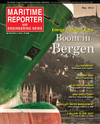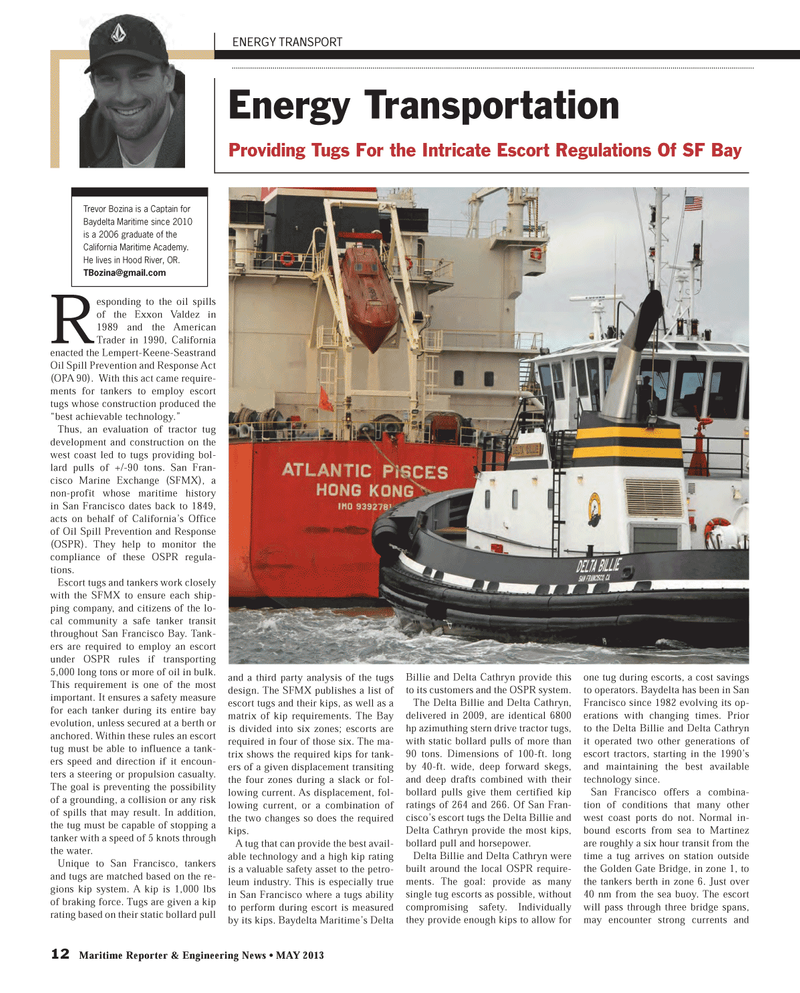
Page 12: of Maritime Reporter Magazine (May 2013)
Energy Production & Transportation
Read this page in Pdf, Flash or Html5 edition of May 2013 Maritime Reporter Magazine
12 Maritime Reporter & Engineering News ? MAY 2013 ENERGY TRANSPORT Energy Transportation Providing Tugs For the Intricate Escort Regulations Of SF Bay Responding to the oil spills of the Exxon Valdez in 1989 and the American Trader in 1990, California enacted the Lempert-Keene-Seastrand Oil Spill Prevention and Response Act (OPA 90). With this act came require- ments for tankers to employ escort tugs whose construction produced the ?best achievable technology.? Thus, an evaluation of tractor tug development and construction on the west coast led to tugs providing bol-lard pulls of +/-90 tons. San Fran-cisco Marine Exchange (SFMX), a non-profit whose maritime history in San Francisco dates back to 1849, acts on behalf of California?s Office of Oil Spill Prevention and Response (OSPR). They help to monitor the compliance of these OSPR regula-tions.Escort tugs and tankers work closely with the SFMX to ensure each ship-ping company, and citizens of the lo- cal community a safe tanker transit throughout San Francisco Bay. Tank- ers are required to employ an escort under OSPR rules if transporting 5,000 long tons or more of oil in bulk. This requirement is one of the most important. It ensures a safety measure for each tanker during its entire bay evolution, unless secured at a berth or anchored. Within these rules an escort tug must be able to influence a tank-ers speed and direction if it encoun-ters a steering or propulsion casualty. The goal is preventing the possibility of a grounding, a collision or any risk of spills that may result. In addition, the tug must be capable of stopping a tanker with a speed of 5 knots through the water. Unique to San Francisco, tankers and tugs are matched based on the re-gions kip system. A kip is 1,000 lbs of braking force. Tugs are given a kip rating based on their static bollard pull and a third party analysis of the tugs design. The SFMX publishes a list of escort tugs and their kips, as well as a matrix of kip requirements. The Bay is divided into six zones; escorts are required in four of those six. The ma- trix shows the required kips for tank-ers of a given displacement transiting the four zones during a slack or fol-lowing current. As displacement, fol- lowing current, or a combination of the two changes so does the required kips.A tug that can provide the best avail- able technology and a high kip rating is a valuable safety asset to the petro-leum industry. This is especially true in San Francisco where a tugs ability to perform during escort is measured by its kips. Baydelta Maritime?s Delta Billie and Delta Cathryn provide this to its customers and the OSPR system.The Delta Billie and Delta Cathryn, delivered in 2009, are identical 6800 hp azimuthing stern drive tractor tugs, with static bollard pulls of more than 90 tons. Dimensions of 100-ft. long by 40-ft. wide, deep forward skegs, and deep drafts combined with their bollard pulls give them certified kip ratings of 264 and 266. Of San Fran-cisco?s escort tugs the Delta Billie and Delta Cathryn provide the most kips, bollard pull and horsepower. Delta Billie and Delta Cathryn were built around the local OSPR require-ments. The goal: provide as many single tug escorts as possible, without compromising safety. Individually they provide enough kips to allow for one tug during escorts, a cost savings to operators. Baydelta has been in San Francisco since 1982 evolving its op-erations with changing times. Prior to the Delta Billie and Delta Cathryn it operated two other generations of escort tractors, starting in the 1990?s and maintaining the best available technology since.San Francisco offers a combina- tion of conditions that many other west coast ports do not. Normal in-bound escorts from sea to Martinez are roughly a six hour transit from the time a tug arrives on station outside the Golden Gate Bridge, in zone 1, to the tankers berth in zone 6. Just over 40 nm from the sea buoy. The escort will pass through three bridge spans, may encounter strong currents and Trevor Bozina is a Captain for Baydelta Maritime since 2010 is a 2006 graduate of the California Maritime Academy. He lives in Hood River, OR. [email protected] #5 (10-17).indd 12MR #5 (10-17).indd 125/2/2013 9:05:24 AM5/2/2013 9:05:24 AM

 11
11

 13
13
